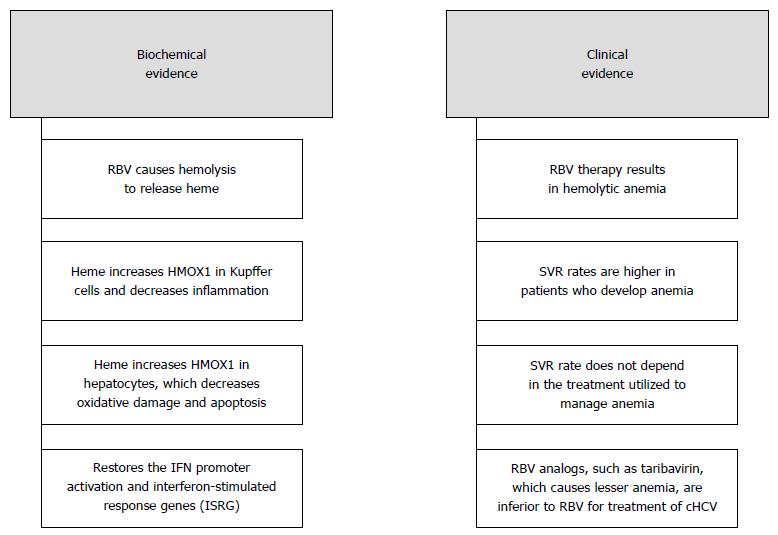Copyright
©2014 Baishideng Publishing Group Inc.
World J Gastroenterol. Nov 21, 2014; 20(43): 16184-16190
Published online Nov 21, 2014. doi: 10.3748/wjg.v20.i43.16184
Published online Nov 21, 2014. doi: 10.3748/wjg.v20.i43.16184
Figure 1 Opposing actions of ribavirin and HCV on cellular HMOX1 concentration.
Ribavirin releases heme from erythrocytes through passive hemolysis. The uptake of heme by hepatocytes (via CD91) and Kupffer cells (via CD163) activates heme oxygenase. HMOX1 acts as a powerful anti-inflammatory and anti-oxidant in Kupffer cells, whereas it has anti-apoptotic and weak antiviral properties when expressed in hepatocytes. HCV core protein inhibits HMOX1 in both of these cells, producing contrasting actions. This inhibition perpetuates viremia and results in immune tolerance, decreasing the efficiency of IFN in clearing HCV. Heme may be able to reverse the blocking effect of Hepatitis C on HMOX1. CD91: Receptor for the heme-hemopexin complex on hepatocytes. This receptor mediates heme uptake, HMOX1 activation. HCV: Hepatitis C virus; HMOX1: Heme Oxygenase - 1; RBV: Ribavirin; IFN: Interferon.
Figure 2 Summary of the bio-chemical and clinical evidence of our proposed hypothesis.
Ribavirin leads to passive hemolysis to release heme which activates HMOX1 in the liver and produces a synergistic effect with IFN on cHCV infection. HMOX1: Heme Oxygenase - 1; IFN: Interferon.
- Citation: Soota K, Maliakkal B. Ribavirin induced hemolysis: A novel mechanism of action against chronic hepatitis C virus infection. World J Gastroenterol 2014; 20(43): 16184-16190
- URL: https://www.wjgnet.com/1007-9327/full/v20/i43/16184.htm
- DOI: https://dx.doi.org/10.3748/wjg.v20.i43.16184










